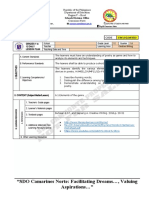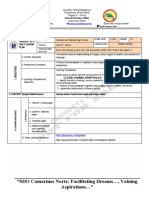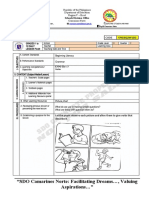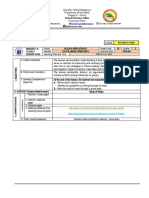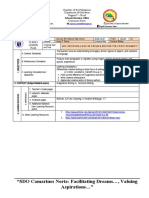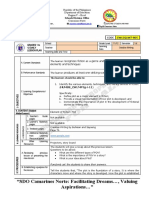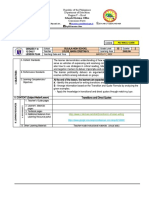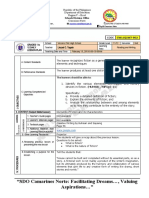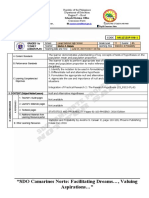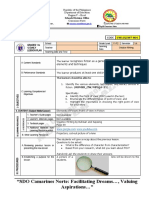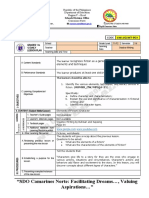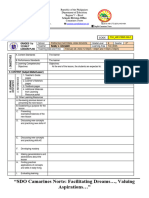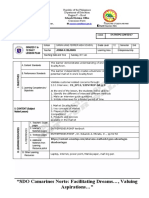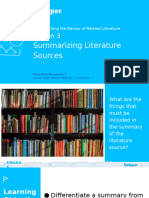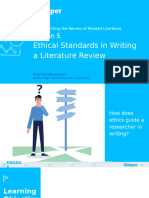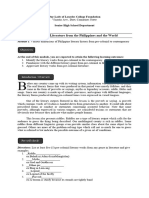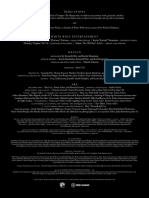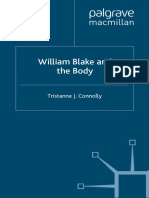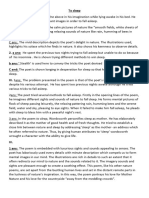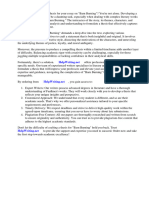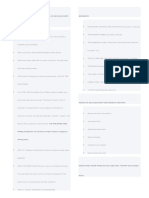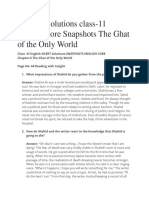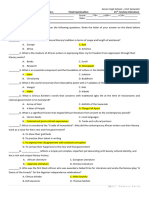CW11Q1W5D2
CW11Q1W5D2
Uploaded by
Josua GarciaCopyright:
Available Formats
CW11Q1W5D2
CW11Q1W5D2
Uploaded by
Josua GarciaOriginal Description:
Copyright
Available Formats
Share this document
Did you find this document useful?
Is this content inappropriate?
Copyright:
Available Formats
CW11Q1W5D2
CW11Q1W5D2
Uploaded by
Josua GarciaCopyright:
Available Formats
Republic of the Philippines
Department of Education
Region V – Bicol
Schools Division Office
Camarines Norte
Eco Athletic Field, F. Pimentel Ave., camarines.norte@deped.gov.ph (054) 440-1772/(054) 440-4464
Daet, Camarines Norte DepEd Camarines Norte
CODE CW11Q1W5D2
GRADES 1 to School Grade Level 12 Quarter 1st
12 DAILY Teacher Learning Area Creative Writing
LESSON PLAN Teaching Date and Time
The learners have an understanding of poetry as a genre and how to analyze its
A. Content Standards
elements and techniques.
B. Performance
I. OBJECTIVES
The learners shall be able to produce a short, well-crafted poem.
Standards
The learners use selected elements of poetry in short exercises.
C.Learning HUMSS_CW/MP11/12c-f-8
Competencies/ 1. Distinguish the different elements of poetry used in the text;
Objectives 2. Construct short poem using elements of poetry; and
3. Demonstrate understanding of the elements through writing a short poem.
II. CONTENT (Subject
Elements of Poetry
Matter/Lesson)
1. Teacher’s
Guide pages
2. Learner’s
Materials
pages
III. LEARNING RESOURCES
A. REFERENCES
3. Textbook
pages
http://englishlinx.com/cgi-bin/pdf_viewer.cgi?script_name=%2Fpdf%2FSimiles-or-Metaphors-P-1-
4. Additional Intermediate.pdf&x=108&y=0
Materials from https://www.anderson1.k12.sc.us/cms/lib04/SC01000609/Centricity/Domain/377/
figurativelanguagekit.pdf
Learning https://courses.lumenlearning.com/atd-distanceminnesota-creativewriting/chapter/rubric-figure-of-
Resource speech-poem/
portal https://www.ereadingworksheets.com/figurative-language-worksheets/figurative-language-poem-07/
preview/figurative-language-poem-07-01.jpg
B. Other Learning
Resources
“SDO Camarines Norte: Facilitating Dreams…, Valuing
Aspirations…”
Republic of the Philippines
Department of Education
Region V – Bicol
Schools Division Office
Camarines Norte
Eco Athletic Field, F. Pimentel Ave., camarines.norte@deped.gov.ph (054) 440-1772/(054) 440-4464
Daet, Camarines Norte DepEd Camarines Norte
Group Activity (10 minutes)
Divide the class into two groups. The teacher will show eight sentences
containing simile and metaphor. Students are going to raise the flash
cards with the word SIMILE or METAPHOR if they think it is the
answer.
A. Reviewing previous
Answers:
lesson or presenting
1. That man is an ogre. 1. metaphor
the new lesson
2. He is as smart as a fox. 2. simile
3. The football p-layer is a giant. 3. metaphor
4. My abs are hard like a rock. 4. simile
5. The boy is a volcano ready to explode. 5. metaphor
6. He is quick as a cat. 6. simile
7. Please do not cry like a baby. 7. simile
8. He has a heart of a lion. 8. metaphor
(5 minutes)
Ask students to identify the words with sounds that suggest meaning.
1. The bees buzzed by flying back to their hive.
2. Click the button to take the picture.
3. The pig squealed when it saw the dog coming.
B. Establishing a Ask the students to look for the words which show exaggeration.
purpose for the 1. The walk was a million miles long!
lesson 2. I ate five-thousand pancakes for breakfast!
3. The bag of gifts weighs a ton!
This time, ask the students to identify words which show human
qualities.
1. The tree leaves danced in the wind.
2. The chair stood up straight and tall.
3. The car jumped to the finish line.
(5 minutes)
Ask the students to read and observe the words used in the poem. Have them
explain what they noticed about the words in bold letters.
C.Presenting
And answer made the bold Sir Bedivere:
examples/instances
of the new lesson "I heard the ripple washing in the reeds,
And the wild water lapping on the crag."
IV. PROCEDURES
(MOrte D’Arthur)
D.Discussing new (5 minutes)
concepts and Study the following lines from a poem. Ask the students what figure of speech is
practicing new skills used by the poet.
#1
“SDO Camarines Norte: Facilitating Dreams…, Valuing
Aspirations…”
Republic of the Philippines
Department of Education
Region V – Bicol
Schools Division Office
Camarines Norte
Eco Athletic Field, F. Pimentel Ave., camarines.norte@deped.gov.ph (054) 440-1772/(054) 440-4464
Daet, Camarines Norte DepEd Camarines Norte
Hadn’t she felt it in every touch of the sunshine, as its golden finer-tips pressed her
lids open and wound their way through her hair?
“The Mother’s Recompense” by Edith Wharton)
(5 minutes)
Study the following lines from a poem. Ask the students what figure of speech is
used by the poet.
E. Discussing new
I’ll love you, dear, I’ll love you
concepts and
Till China and Africa meet,
practicing skills #2
And the river jumps over the mountain
And the salmon sing in the street.”
(“As I Walked Out One Evening” by W.H. Auden)
(10 minutes)
A Lady 1. A woman’s bedroom or private room.
by: Amy Lowell 2. Gradually spread through or over.
3. Physical strength and good health
You are beautiful and faded
Like an old opera tune Questions:
Played upon a harpsichord;
Or like the sun-flooded silks 1. Identify one example of
Of an eighteenth-century boudoir1. personification. Explain what is
In your eyes being personified and how.
F. Developing mastery Smoulder the fallen roses of outlived minutes,
And the perfume of your soul 2. Identify one example of
Is vague and suffusing2. hyperbole. Explain what is
With the pungence of sealed spice-jars being exaggerated.
Your half-tones delight me,
And I grow mad with gazing 3. What is the subject of this
At your blent colors. poem? What is this poem
about? Explain your answer.
My vigor3 is a new-minted penny,
Which I cast at your feet.
Gather it up from the dust,
That its sparkle may amuse you.
G.Finding practical
(5 minutes)
applications of
Ask:
concepts and skills in
daily living What is the importance of using figures of speech in creative writing?
“SDO Camarines Norte: Facilitating Dreams…, Valuing
Aspirations…”
Republic of the Philippines
Department of Education
Region V – Bicol
Schools Division Office
Camarines Norte
Eco Athletic Field, F. Pimentel Ave., camarines.norte@deped.gov.ph (054) 440-1772/(054) 440-4464
Daet, Camarines Norte DepEd Camarines Norte
(5 minutes)
1. Personification - Giving life to inanimate objects.
Example: “He rolls on the beach all day.”
Note: The poet gives a human form to the sea by calling it “he.”
H.Making 2. Hyperbole uses extreme exaggeration. It exaggerates to lay emphasis on
generalizations and
a certain quality or feature. It stirs up emotions among the readers; these
abstractions about
emotions could be about happiness, romance, inspiration, laughter or
the lesson
sadness.
3. Onomatopoeia includes words that mimic the actual sounds we hear. For
example, bark came about because it mimics the actual sound a dog
makes. Also, a bell clangs in the night, also mimicking the actual sound.
(10 minutes)
Write a short poem containing figures of speech like personification, hyperbole and
onomatopoeia.
Rubric: Figure of Speech Poem
Poetic Voice Score Comments
Consistently in first-person
point of view or third-person 5/5
point of view
Includes a figure of speech:
simile, metaphor,
personification or hyperbole
I. Evaluating learning Word Choice
Specific nouns
Action verbs 10/10
Does not use unnecessary
words: very, really, always,
gotten
Format
Single-spaced
One white space between
stanzas 10/10
Left-justified rather than
centered
Title included
Name heading
1″ margins
J. Additional activities In your notebook, write sentences using personification, hyperbole and
for application or onomatopoeia. Provide 2 samples for each.
“SDO Camarines Norte: Facilitating Dreams…, Valuing
Aspirations…”
Republic of the Philippines
Department of Education
Region V – Bicol
Schools Division Office
Camarines Norte
Eco Athletic Field, F. Pimentel Ave., camarines.norte@deped.gov.ph (054) 440-1772/(054) 440-4464
Daet, Camarines Norte DepEd Camarines Norte
remediation
V. REMARKS
A. No. of learners who
earned 80% in the
evaluation
B. No. of learners who
require additional
activities for
remediation
C.Did the lesson work?
No. of learners who
have caught up w/ the
lesson
VI. REFLECTION
D.No. of learners who
continue to require
remediation
E. Which of my teaching
strategies worked
well? Why did these
work?
F. What difficulties did I
encounter which my
principal or supervisor
can help me solve?
G.What innovation or
localized materials did
I use/discover which I
wish to share with
other teachers?
PROCEDURES NOTES / SUGGESTIONS / RECOMMENDATIONS
A. Reviewing previous lesson
or presenting the new
lesson
B. Establishing a purpose for
the lesson
C. Presenting
examples/instances of the
new lesson
D. Discussing new concepts
and practicing new skills #1
“SDO Camarines Norte: Facilitating Dreams…, Valuing
Aspirations…”
Republic of the Philippines
Department of Education
Region V – Bicol
Schools Division Office
Camarines Norte
Eco Athletic Field, F. Pimentel Ave., camarines.norte@deped.gov.ph (054) 440-1772/(054) 440-4464
Daet, Camarines Norte DepEd Camarines Norte
E. Discussing new concepts
and practicing skills #2
F. Developing mastery
G. Making generalizations and
abstractions about the
lesson
H. Finding practical
applications of concepts
and skills in daily living
I. Evaluating learning
J. Additional activities for
application or remediation
“SDO Camarines Norte: Facilitating Dreams…, Valuing
Aspirations…”
You might also like
- Key Extracts BookletDocument15 pagesKey Extracts BookletClaire Andrews0% (1)
- lESSON PLAN 3is 6Document7 pageslESSON PLAN 3is 6Aiza AbantoNo ratings yet
- CW11Q1W3D3Document7 pagesCW11Q1W3D3Josua GarciaNo ratings yet
- CW11Q1W5D1Document7 pagesCW11Q1W5D1Josua GarciaNo ratings yet
- CW11Q1W3D1Document6 pagesCW11Q1W3D1Josua GarciaNo ratings yet
- CW11Q1W4D1Document6 pagesCW11Q1W4D1Josua GarciaNo ratings yet
- Cot - DLPDocument6 pagesCot - DLPJosua GarciaNo ratings yet
- EAPPW3D4Document7 pagesEAPPW3D4Jolina SalenNo ratings yet
- SDO Camarines Norte: Facilitating Dreams, Valuing AspirationsDocument7 pagesSDO Camarines Norte: Facilitating Dreams, Valuing AspirationsMaribeth AbantoNo ratings yet
- EAPPW3D2Document7 pagesEAPPW3D2Jolina SalenNo ratings yet
- CW11Q1W2D2Document6 pagesCW11Q1W2D2Josua GarciaNo ratings yet
- CW11Q1W4D2Document7 pagesCW11Q1W4D2Josua GarciaNo ratings yet
- CW11Q1W2D4Document6 pagesCW11Q1W2D4Josua GarciaNo ratings yet
- OC11Q1W3D1 Draft 1 TrueDocument6 pagesOC11Q1W3D1 Draft 1 TrueChristine ApinNo ratings yet
- Detailed Lesson Plan - DepedDocument10 pagesDetailed Lesson Plan - Depedleonardoalbor05No ratings yet
- Cot Angie CircleDocument10 pagesCot Angie CirclegerabunaoNo ratings yet
- COT G10 Mar 21Document7 pagesCOT G10 Mar 21Cristina LolosNo ratings yet
- Abmae12 Iw5d1Document6 pagesAbmae12 Iw5d1Arlene Caceres GacheNo ratings yet
- CW11Q1W7 9D11Document5 pagesCW11Q1W7 9D11Josua GarciaNo ratings yet
- SDO Camarines Norte: Facilitating Dreams, Valuing AspirationsDocument6 pagesSDO Camarines Norte: Facilitating Dreams, Valuing AspirationsSalve SerranoNo ratings yet
- EAPPW2D4Document6 pagesEAPPW2D4Jolina SalenNo ratings yet
- CW11Q1W2D3Document6 pagesCW11Q1W2D3Josua GarciaNo ratings yet
- CW11Q1W2D1Document6 pagesCW11Q1W2D1Josua GarciaNo ratings yet
- COT G10 Mar 16Document8 pagesCOT G10 Mar 16Cristina LolosNo ratings yet
- CW11Q1W1D1Document6 pagesCW11Q1W1D1Josua GarciaNo ratings yet
- Orgt MGTDocument5 pagesOrgt MGTRoserain AecabNo ratings yet
- CW11Q1W7 9D7Document7 pagesCW11Q1W7 9D7Josua GarciaNo ratings yet
- Lesson Plan 5 3isDocument6 pagesLesson Plan 5 3isAiza AbantoNo ratings yet
- CW11Q1W7 9D5Document9 pagesCW11Q1W7 9D5Josua GarciaNo ratings yet
- EAPP11S1Q1W7D2Document9 pagesEAPP11S1Q1W7D2melany r. malvarosaNo ratings yet
- COT G10 Mar 17Document9 pagesCOT G10 Mar 17Cristina LolosNo ratings yet
- Grade 10-Observing Correct Grammar in Making DefinitionsDocument8 pagesGrade 10-Observing Correct Grammar in Making DefinitionsLeah MatiasNo ratings yet
- 2024-dlp q1 Particles of ModelDocument11 pages2024-dlp q1 Particles of ModelJeanisil CerenoNo ratings yet
- SDO Camarines Norte: Facilitating Dreams, Valuing AspirationsDocument5 pagesSDO Camarines Norte: Facilitating Dreams, Valuing AspirationsJessalyn RadaNo ratings yet
- 2024-dlp q1 Particles of Model TrueDocument11 pages2024-dlp q1 Particles of Model TrueJeanisil CerenoNo ratings yet
- MATH10Q1W1D2Document5 pagesMATH10Q1W1D2leonardoalbor05No ratings yet
- SDO Camarines Norte: Facilitating Dreams, Valuing AspirationsDocument7 pagesSDO Camarines Norte: Facilitating Dreams, Valuing AspirationsSalve SerranoNo ratings yet
- CW11Q1W7 9D2Document6 pagesCW11Q1W7 9D2Josua GarciaNo ratings yet
- SDO Camarines Norte: Facilitating Dreams, Valuing AspirationsDocument7 pagesSDO Camarines Norte: Facilitating Dreams, Valuing Aspirationsrosefraga95No ratings yet
- CW11Q1W7 9D8Document6 pagesCW11Q1W7 9D8Josua GarciaNo ratings yet
- Grade 10-GIVING EXPANDED DEFINITIONS OF WORDSDocument7 pagesGrade 10-GIVING EXPANDED DEFINITIONS OF WORDSLeah MatiasNo ratings yet
- DLP-INTRO TO PHILO Week 2Document6 pagesDLP-INTRO TO PHILO Week 2Ann Maureen ConcepcionNo ratings yet
- SDO Camarines Norte: Facilitating Dreams, Valuing AspirationsDocument8 pagesSDO Camarines Norte: Facilitating Dreams, Valuing AspirationsAnn Maureen ConcepcionNo ratings yet
- CW11Q1W3D4Document6 pagesCW11Q1W3D4Josua GarciaNo ratings yet
- EAPP11S1Q1W7D2Document11 pagesEAPP11S1Q1W7D2melany r. malvarosaNo ratings yet
- EAPPW3D3Document6 pagesEAPPW3D3Jolina SalenNo ratings yet
- SDO Camarines Norte: Facilitating Dreams, Valuing AspirationsDocument8 pagesSDO Camarines Norte: Facilitating Dreams, Valuing AspirationsSalve SerranoNo ratings yet
- Eng9 Q1W1D3Document6 pagesEng9 Q1W1D3Kuting MVNo ratings yet
- EAPP11S1Q1W7D1Document9 pagesEAPP11S1Q1W7D1melany r. malvarosaNo ratings yet
- CW11Q1W7 9D12Document5 pagesCW11Q1W7 9D12Josua GarciaNo ratings yet
- Grade 10-Quarter 3 - DLPDocument8 pagesGrade 10-Quarter 3 - DLPLeah MatiasNo ratings yet
- CW11Q1W7 9D4Document6 pagesCW11Q1W7 9D4Josua GarciaNo ratings yet
- Final Polygon LPDocument9 pagesFinal Polygon LPKristine BuñaNo ratings yet
- CW11Q1W7 9D6Document7 pagesCW11Q1W7 9D6Josua GarciaNo ratings yet
- MATH10Q1W7D25Document8 pagesMATH10Q1W7D25leonardoalbor05No ratings yet
- CW11Q1W7 9D3Document6 pagesCW11Q1W7 9D3Josua GarciaNo ratings yet
- Schools Division Office: Perform Hand and Foot Spa (HS)Document6 pagesSchools Division Office: Perform Hand and Foot Spa (HS)Divina ArevaloNo ratings yet
- DLP-INTRO TO PHILO Q2 Week 1Document6 pagesDLP-INTRO TO PHILO Q2 Week 1Ann Maureen ConcepcionNo ratings yet
- LP BlankDocument3 pagesLP BlankVillaluz Delos Reyes ZharinaNo ratings yet
- Entrep Lesson PlanDocument8 pagesEntrep Lesson PlanRoserain AecabNo ratings yet
- Teacher Guide for A Girl Called Echo: Learning About the History and Culture of the Métis Nation in Grades 6–8From EverandTeacher Guide for A Girl Called Echo: Learning About the History and Culture of the Métis Nation in Grades 6–8No ratings yet
- ET Q1 W3Document4 pagesET Q1 W3Josua GarciaNo ratings yet
- Summarizing Literature SourcesDocument33 pagesSummarizing Literature SourcesJosua Garcia100% (1)
- Valencia Aubrey ABM12 Gokongwei Week 1Document8 pagesValencia Aubrey ABM12 Gokongwei Week 1Josua GarciaNo ratings yet
- Module 3Document3 pagesModule 3Josua GarciaNo ratings yet
- Module 2Document4 pagesModule 2Josua GarciaNo ratings yet
- LESSON 4 - Listing ReferencesDocument40 pagesLESSON 4 - Listing ReferencesJosua GarciaNo ratings yet
- Ethical Standards in Writing Literature ReviewDocument33 pagesEthical Standards in Writing Literature ReviewJosua GarciaNo ratings yet
- Answer Key - Pretest PR 2Document4 pagesAnswer Key - Pretest PR 2Josua GarciaNo ratings yet
- SHS Grade11&12 21stCenturyLiteraturefromthePhilippinesandtheWorldModule1 GarciaJDocument4 pagesSHS Grade11&12 21stCenturyLiteraturefromthePhilippinesandtheWorldModule1 GarciaJJosua GarciaNo ratings yet
- Research - Gas A GroupingsDocument1 pageResearch - Gas A GroupingsJosua GarciaNo ratings yet
- 7 Cash Disbursement JournalDocument1 page7 Cash Disbursement JournalJosua GarciaNo ratings yet
- PreliminariesDocument5 pagesPreliminariesJosua GarciaNo ratings yet
- CW11Q1W7 9D8Document6 pagesCW11Q1W7 9D8Josua GarciaNo ratings yet
- CW11Q1W7 9D4Document6 pagesCW11Q1W7 9D4Josua GarciaNo ratings yet
- CW11Q1W7 9D11Document5 pagesCW11Q1W7 9D11Josua GarciaNo ratings yet
- CW11Q1W7 9D7Document7 pagesCW11Q1W7 9D7Josua GarciaNo ratings yet
- CW11Q1W7 9D12Document5 pagesCW11Q1W7 9D12Josua GarciaNo ratings yet
- CW11Q1W7 9D2Document6 pagesCW11Q1W7 9D2Josua GarciaNo ratings yet
- CW11Q1W4D2Document7 pagesCW11Q1W4D2Josua GarciaNo ratings yet
- CW11Q1W7 9D3Document6 pagesCW11Q1W7 9D3Josua GarciaNo ratings yet
- CW11Q1W7 9D5Document9 pagesCW11Q1W7 9D5Josua GarciaNo ratings yet
- CW11Q1W7 9D6Document7 pagesCW11Q1W7 9D6Josua GarciaNo ratings yet
- CW11Q1W3D4Document6 pagesCW11Q1W3D4Josua GarciaNo ratings yet
- CW11Q1W1D3Document5 pagesCW11Q1W1D3Josua GarciaNo ratings yet
- CW11Q1W1D1Document6 pagesCW11Q1W1D1Josua GarciaNo ratings yet
- Instant Ebooks Textbook The Taming of The Shrew 2e Edition Shakespeare William Download All ChaptersDocument76 pagesInstant Ebooks Textbook The Taming of The Shrew 2e Edition Shakespeare William Download All Chaptersstegenchoute100% (1)
- Oscar Wilde - The Importance of Being EarnestDocument63 pagesOscar Wilde - The Importance of Being EarnestCristina Faalam GrumalNo ratings yet
- Guideline To Composition Writing Intro Body ComclusionDocument3 pagesGuideline To Composition Writing Intro Body ComclusionEstefania LunaNo ratings yet
- (Duchess Quartet 1) James, Eloisa - Duchess in Love - Libgen - LiDocument2 pages(Duchess Quartet 1) James, Eloisa - Duchess in Love - Libgen - LiMichael EkubaselasieNo ratings yet
- Analysis Questions Dead Poets Society (II)Document3 pagesAnalysis Questions Dead Poets Society (II)Maria PiaNo ratings yet
- 003Document1 page003Алексей ГончаровNo ratings yet
- Tristanne J Connolly-William Blake and The Body-Palgrave Macmillan 2002Document268 pagesTristanne J Connolly-William Blake and The Body-Palgrave Macmillan 2002sf39armyNo ratings yet
- Semester 2 Paper Pattern English 11th STD March 2024Document2 pagesSemester 2 Paper Pattern English 11th STD March 2024shaistaNo ratings yet
- To SleepDocument2 pagesTo Sleepajsensen34No ratings yet
- Movie Review On Chiraq CADocument4 pagesMovie Review On Chiraq CAIlma NoorNo ratings yet
- Good Thesis For Barn BurningDocument8 pagesGood Thesis For Barn Burningreneereedpittsburgh100% (2)
- ZZ Packers Drinking Coffee Elsewhere A Serious atDocument12 pagesZZ Packers Drinking Coffee Elsewhere A Serious atAhmad Hasan RahmatullahNo ratings yet
- Performance WritingDocument8 pagesPerformance WritingSimona PopNo ratings yet
- BenitoDocument2 pagesBenitoFrancis SensonNo ratings yet
- The Canterville Ghost: Chapter 3-4 1. Answer The QuestionsDocument1 pageThe Canterville Ghost: Chapter 3-4 1. Answer The QuestionsMariaNo ratings yet
- NCERT Solutions For Class 11 English Snapshots Chapter 6Document2 pagesNCERT Solutions For Class 11 English Snapshots Chapter 6PRIYANSHU SINGHNo ratings yet
- A Sunny MorningDocument12 pagesA Sunny MorningThakur BhatNo ratings yet
- 10.12987 9780300224825-001Document18 pages10.12987 9780300224825-001georgebrookshawNo ratings yet
- The Scribes and Correctors of Codex Vaticanus A Study On The Codicology Paleography and Text of B 03Document4 pagesThe Scribes and Correctors of Codex Vaticanus A Study On The Codicology Paleography and Text of B 03mujalachipego21No ratings yet
- PNP Files RandomDocument12 pagesPNP Files RandomLucy FferNo ratings yet
- 21st Century Lit Week1Document3 pages21st Century Lit Week1Aloc Mavic100% (3)
- History of Modern France (True)Document73 pagesHistory of Modern France (True)inika090No ratings yet
- Silva's Poem AnalysisDocument3 pagesSilva's Poem AnalysisGabriel GoulartNo ratings yet
- Greek Mythology PretestDocument1 pageGreek Mythology Pretestg.malchukNo ratings yet
- Literary Analysis EssayDocument8 pagesLiterary Analysis Essayafhbgaohb100% (1)
- Darke Hierogliphicks Alchemy in English Literature From Chaucer To The Restoration by Stanton J. LindenDocument384 pagesDarke Hierogliphicks Alchemy in English Literature From Chaucer To The Restoration by Stanton J. LindenMischievousLoki100% (1)
- Books Lovelife ScriptDocument4 pagesBooks Lovelife ScriptMafet AlcaldeNo ratings yet
- TH Phiên Dịch - Group 1Document58 pagesTH Phiên Dịch - Group 1An PhanNo ratings yet
- Q2 Exam in 21ST CenturyDocument4 pagesQ2 Exam in 21ST CenturyMaricris FerrerNo ratings yet


